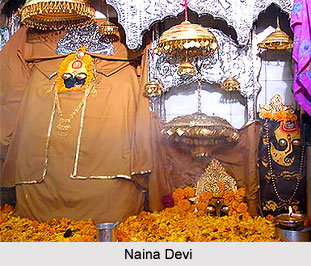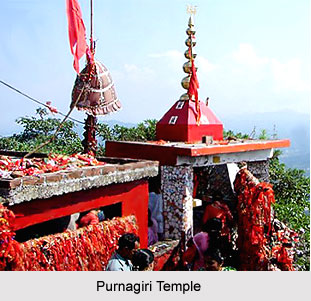 Folk gods of Kumaon are popular and they have rich history. The people of Kumaon worship folk deities apart from Shakti and Lord Shiva. The heroes of ancient times have become folk gods and they provide expression to the famous and popular ideas of the people. Each and every folk god has a separate story to tell and they are remembered through some of the temple, peak and jagar (a form of ritual folk poem). It is often said that Kumaon had a tradition of Yaksha worship.
Folk gods of Kumaon are popular and they have rich history. The people of Kumaon worship folk deities apart from Shakti and Lord Shiva. The heroes of ancient times have become folk gods and they provide expression to the famous and popular ideas of the people. Each and every folk god has a separate story to tell and they are remembered through some of the temple, peak and jagar (a form of ritual folk poem). It is often said that Kumaon had a tradition of Yaksha worship.
The presence of snake worship or "Naga" is a sign of respect and admiration given to the brave. Apart from worshiping the usual gods and goddesses of the Hindus, the people of Kumaon also worship Kul Devatas (family gods), Naga Devatas (snake gods), Gram Devatas village gods), Bhumi Devatas (land gods) and Veers (the brave heroes). Some of the popular and important gods and goddesses of Kumaon are as follows:
 Naina Devi
Naina Devi
Naina Devi is another name given to goddess Parvati. According to the information available from Jagars, Naina Devi was set up in Kumaon by the Katyuri Queen Jiya Rani. Apart from this there is also a myth which talks of Sati`s committing suicide by jumping into the fire, when her father Dakshaprajapati, insulted her and Lord Shiva during a Yajnya, to which Shiva and Sati had not been invited in the first place. Myth has it that while Lord Shiva was carrying the dead body of Parvati, her eye fell down at a spot near the temple of Pashan Devi in Nainital. So according to the legend Naina Devi is none other than goddess Parvati or Sati (the avatar in which she was reborn as).
Nanda Devi
Nanda Devi is actually the Greek Goddess "Nana" who came to the Himalaya Mountain with the Kushan Kings and Indo-Greeks. However the fact remains that Nanda Devi is actually a Kumaoni goddess and most famous in the region.
Bholanath
One of the most popular and revered folk god of Kumaon is known as Bholanath. He is believed to be the incarnation of Lord Shiva. According to the legends, the Udai Chand, Chand King disowned his elder son because of his bad habits and gave the kingdom to his younger son. His elder son, after wondering for a long time, came with his pregnant wife and started living near the region of Almora. But the king had both of them executed. The wife, the son and their two unborn children became ghosts and people started worshipping them. The main temple of Bholanath is located at Champawat.
Gwalla
Gwalla is popularly known as Golla, Golu Devata and Gorilla. Flags and banners are suspended over many temples in honour of Gwalla. The Gwalla temples are located at Champawat, Chitai and Ghorakhal. Out of all the three the temple at Chaiti is most famous among them. The story that surrounds Gwalla talks of a local king who had sent her servant to fetch water while he was out hunting. The servant disturbed a woman who was praying and she in fit of anger taunted the king that he could not separate two fighting bulls and went ahead to do that herself. This particular deed impressed the king a lot and he married the woman.
When this queen had a son, the other queens, who were extremely jealous of her, placed a pumpkin in place of the child and caged the child and put the cage into river. Fisherman who got hold of the cage brought up the child. When this boy grew up he took the wooden horse to the river and when he was questioned by the queens regarding the same, he said that if women can give birth to pumpkins then wooden horses can drink water too. King, when came to know of the entire story severely punished the guilty queens and crowned the boy, who actually went on to be known as Gwalla devata.
Airy
 Airy is a local god whose eyes are on the top of his head and is worshipped like the God Shani. His attendants, "Bhau" and "Sau" ride on dogs. This god is said to look after the animals it is worshipped in this form itself. There are many temples of Airy that are located in Kumaon but the main temple is situated in Byandhura.
Airy is a local god whose eyes are on the top of his head and is worshipped like the God Shani. His attendants, "Bhau" and "Sau" ride on dogs. This god is said to look after the animals it is worshipped in this form itself. There are many temples of Airy that are located in Kumaon but the main temple is situated in Byandhura.
Kail Bisht
Among all the folk gods of Kumaon, Kail Bisht is said to be most generous. The temple of Kail Bisht, flute playing god, is located near Binsar. There are mythical stories that go around regarding the love affair of Srikrishna Pandey`s wife and a brave Rajput shepherd Kallu (Kail Bisht). When the matter was brought to the notice of king, he refused to execute Kail Bisht because he saw the impression of a trident on Kail Bisht`s forehead and that of a Kadamb flower on his feet. However, later Kallu was murdered by trickery.
Chaumu
This god is mainly known as protector of animals and found particularly in Jhulaghat-Pancheswar region. The story goes that a man was going to Champawat with Shivlinga in his turban. On his way, he stopped to drink water, hence placed his turban on the road, but later could not pick it up again.
People of Kumaon started to worship this place. Milk and bells are offered in the temples of Chaumu at Chaupakhia (Wadda, Pithoragarh), Chamdeval (Pulla, Champawat), Pancheswar, Thathgaon (Almora), Dhamkuri, Surar and Santola (all in Nepal). This is basically the seat of seven brothers. Chamdeval is the major seat of Chaumu.
Haru
The famous king of Champawat was Harish Chandra, and after his death was worshipped as folk god named Haru. Haru is said to be Gwall`s maternal uncle and his mother`s name is Kainar. The temples of Saim and Haru, the god of boundaries, are mainly seen together. Apart from them there are other folk gods that are worshipped in Kumaon, and some of them are as follows; Bhumia, Bhandari Golla, Badhan, Balchan, Nagnath, Narsingh, Chhurmal, Lataul, Gabla etc. Ujyali and Anyari are the admired goddesses. Garh Devis are found in cremation grounds and are actually worshipped on the night of Amavasya. Although, Sangram Karki, Bafaul, Ramol are also stated as folk figures but are not given the godly status.
Gangnath
The story of this god is very much similar to Bholanath. He was the son of King Vaibhav Chand of Doti (Western Nepal). He quarrelled with his father and left home when he fell in love with a lady who was a Joshi Brahmin known as Bhana. Having got the news Bhana`s husband/father got Gangnath killed by a blacksmith.
When Gangnath started to harm people, they started to worship him just to calm him down. The jagar singers of Kumaon frequently tell tales about the love affair of Gangnath and Bhana. Gangnath temples are stretch all over Kumaon.




















